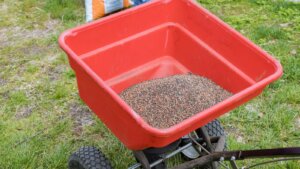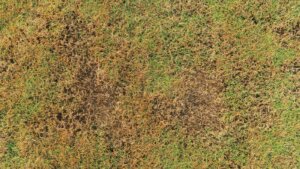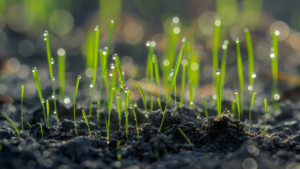Have you applied top dressing to your lawn within the last year? Or ever? If you’re looking to up your lawn game and keep your grass as healthy and full as possible, then top dressing is a vital step. A favorite of golf courses, this process will help your lawn stay lush and healthy.
What is top dressing?
Top dressing involves applying a thin layer of material, like compost, to the top of an existing lawn. The overall goal is to improve the soil structure, fertility and general health of your grass by providing the nutrients necessary to promote healthy, thick grass growth.
Top dressing can also help you adjust the pH level of your lawn’s soil, level low spots and improve drainage for an overall healthier yard. While top dressing is not a magic bullet for solving every single lawn issue, it is a very beneficial piece of routine maintenance that can assist with a wealth of issues, and prevent others entirely.
Before you get busy top dressing, you’ll need to make some decisions, like picking your materials and identifying which problems you’re trying to address. Let’s look at the top dressing process from idea to completion.
Top dressing steps:
The step-by-step process for top dressing a lawn typically includes the following:
1. Mow the lawn
Mow the lawn to a short length, usually about 1 inch, before top dressing. This will help to ensure an even distribution of the top dressing material.
2. Test your soil
Conduct a soil test to determine the pH level, nutrient content, and soil type. This will help you to determine the best type of top dressing material for your lawn. (We’ll discuss topping options further in this guide.)
3. Prepare the top dressing material
If you’re using a purchased top dressing mix, use it as is. If you’re using a material like compost, it should be well-rotted, and sifted through a 1/4-inch mesh screen to remove any clumps or debris.
4. Apply the top dressing
Spread the top dressing material over the lawn using a spreader. Each material will call for a different setting on the spreader.
5. Rake the top dressing
Gently rake the top dressing material into the lawn, being careful not to disturb the soil or damage the grass.
6. Water the lawn
Water the lawn thoroughly to help the top dressing material settle into the soil and to promote seed germination, if you have added seed to the top dressing material.
7. Keep the lawn moist
Keep the lawn well-watered for the next few weeks to ensure the new seed germinates and the top dressing material settles into the soil.
8. Mow the lawn
After a week or two, when the new seed has germinated and the top dressing material has settled, mow the lawn as normal.
Top dressing benefits:
Top dressing your lawn will help it look pristine and professional. However, there are some “invisible” benefits to top dressing, as well.
1. Improving soil structure
Compost is rich in organic matter, which can help improve the structure of the soil. This can lead to better aeration and nutrient availability.
2. Fertilizing the lawn
Compost contains a wide variety of nutrients that are essential for healthy plant growth, including nitrogen, phosphorus, and potassium. This can help promote healthy growth and a lush green lawn.
3. Suppressing weeds
Top dressing can help suppress weed growth by creating a thick, healthy lawn that shades out weeds and by providing competition for the nutrients that weeds need to grow.
4. Enhancing soil biodiversity
Top dressing materials contain a wide variety of microorganisms, which can help improve soil biodiversity. This can lead to a healthier ecosystem and increased resilience to pests and diseases.
5. Reducing water usage and improved drainage
Another benefit of your lawn’s improved soil structure is how it helps with drainage and water retention. Top dressing can help your lawn retain the correct amount of water, cutting down on sprinkler time while still draining thoroughly.
6. Improving the aesthetic appeal of the lawn
Top dressing can give the lawn a thick, green, healthy appearance, which looks great. Top dressing on a regular schedule is one of the secrets to getting your lawn looking pristine and maintained.
What should I use for top dressing lawn materials?
You’ve got several options to choose from when it comes to top dressing lawn materials:
- Compost: Well-rotted compost is a great option for top dressing a lawn. It adds organic matter and improves soil structure, making it easier for roots to penetrate the soil.
- Sand: If your soil is heavy clay and with poor drainage, adding sand to the top dressing can help to improve water movement.
- Peat moss: Peat moss can be used to top dress a lawn to improve soil acidity, which is beneficial for certain types of grasses. Be sure to test your pH before top dressing.
- A blend of materials: A mixture of compost, sand, and topsoil can also be used as top dressing to improve soil structure, fertility and drainage.
- Composted Manure: Composted manure is a great fertilizer for your lawn. It is rich in organic matter and essential nutrients, improving soil structure, fertility and soil microorganisms.
Not sure what to use? You don’t have to guess. A local lawn care service will be able to assess your property and help you choose the best option for your grass. For service in Montgomery County, PA, you can leave all your top dressing needs up to Terra Lawn Care Specialists.
Is top dressing the same as topsoil?
Top dressing and topsoil are similar but not the same. Topsoil refers to the layer of soil at the surface of the ground which is typically rich in organic matter and suitable for growing plants. Top dressing refers to the practice of applying a thin layer of material (such as compost, peat moss, or sand) on top of the existing lawn to improve the soil structure and fertility.
It’s easy to confuse these two lawn care needs. However, the difference is in the overall goal of each process. The main goal of top dressing is to improve soil health and fertility, while the main goal of topsoil is to provide a suitable growing environment for plants.
When should I top dress my lawn?
The best time of year to top dress a lawn is typically in the fall or spring, when the grass is actively growing. This allows the grass to better incorporate the top dressing materials and improves the chances of successful seed germination.
It is important to avoid top dressing during extreme heat or drought conditions as well as during the dormant winter months. Additionally, it is vital to mow the lawn before top dressing and to water the lawn after top dressing to help the grass incorporate the materials. Missing any of these steps can mean seeing fewer benefits from the top dressing.
Do you fertilize before top dressing?
Remember how we said top dressing was no magical cure-all? Top dressing is one very important piece of overall lawn care, and it cannot take the place of proper fertilization.
It is generally recommended to fertilize your lawn before you start top dressing. This is because top dressing materials, such as compost or soil, do not contain the necessary nutrients for healthy grass growth. Fertilizing before top dressing ensures that the grass will actually get grown and have a chance to incorporate the top dressing materials.
Additionally, fertilizing in general can help to improve the overall health of the lawn and encourage deeper roots. Healthier grass will be able to take full advantage of the benefits of top dressing. It is important to use a fertilizer that is appropriate for the type of grass you have, and to apply it according to the manufacturer’s instructions.
Do you overseed before or after top dressing?
Yes, you’ll want to top dress first, then overseed. This allows the top dressing material to settle and create a more consistent seedbed for the overseeding. Additionally, the top dressing can help to keep the newly seeded area moist, which will aid germination.
However, each lawn is unique. If you have never applied top dressing to your lawn before, consult with a professional landscaper or lawn care expert for specific advice on your lawn.
Will grass grow through top dressing?
Grass can potentially grow through top dressing, depending on the thickness of the top dressing material and the type of grass seed being used.
If the top dressing material is applied too thickly, it can act as a barrier and prevent the grass seed from reaching the soil. On the other hand, if the top dressing material is applied in a thin layer and the grass seed is of a species that is well-suited to the local conditions, the grass seed may be able to germinate and grow through the top dressing.
When can I mow after top dressing?
Waiting 24 hours after top dressing before mowing is the absolute minimum. This allows the top dressing material to settle and be distributed evenly across the lawn. Mowing too soon after top dressing can cause the top dressing material to be unevenly distributed and can also damage the new grass seed.
What’s most important is waiting for the new grass seed to germinate, which can actually take several days to a week, depending on the type of grass seed used and the local conditions. When in doubt, it’s better to mow a little later rather than too soon.
How often should you Topdress?
For lawns that are in good condition, top dressing once a year may be sufficient. This will help to maintain soil fertility and provide a consistent seedbed for the grass.
For lawns that have poor soil structure or drainage issues, top dressing twice a year may be necessary. This will help to improve the soil and overall health of the grass. If the root cause of the issues can be solved, then the top dressing may be needed less frequently over time.
Timing is more important than frequency. Top dressing is recommended in late spring or early fall, and it is better to wait for these seasons when the grass is actively growing than to rush just to get another top dressing in within the general recommended timeframe.
Consult with a professional
Top dressing done properly can breathe new life into your lawn. Done poorly, it is a lot of work for little reward. Be sure to talk with an experienced lawn care service to decide when, how often and with what materials you should top dress your lawn. For any lawns in Montgomery County, PA, Terra Lawn Care Specialists is here to help.



